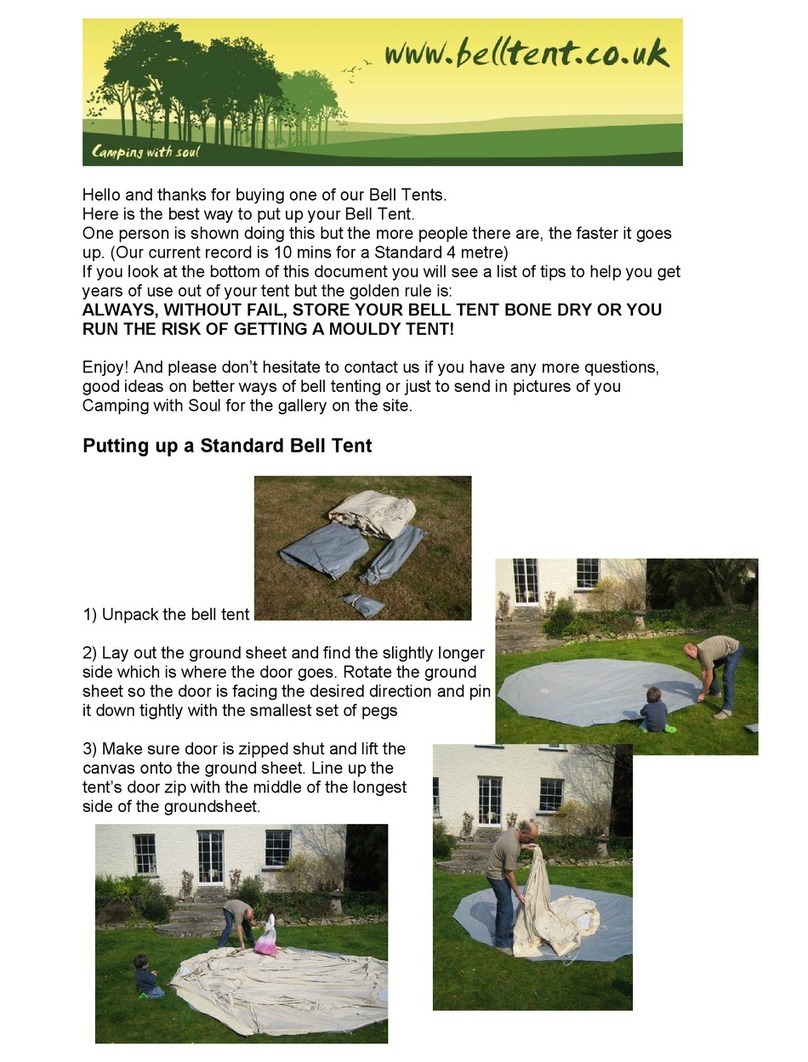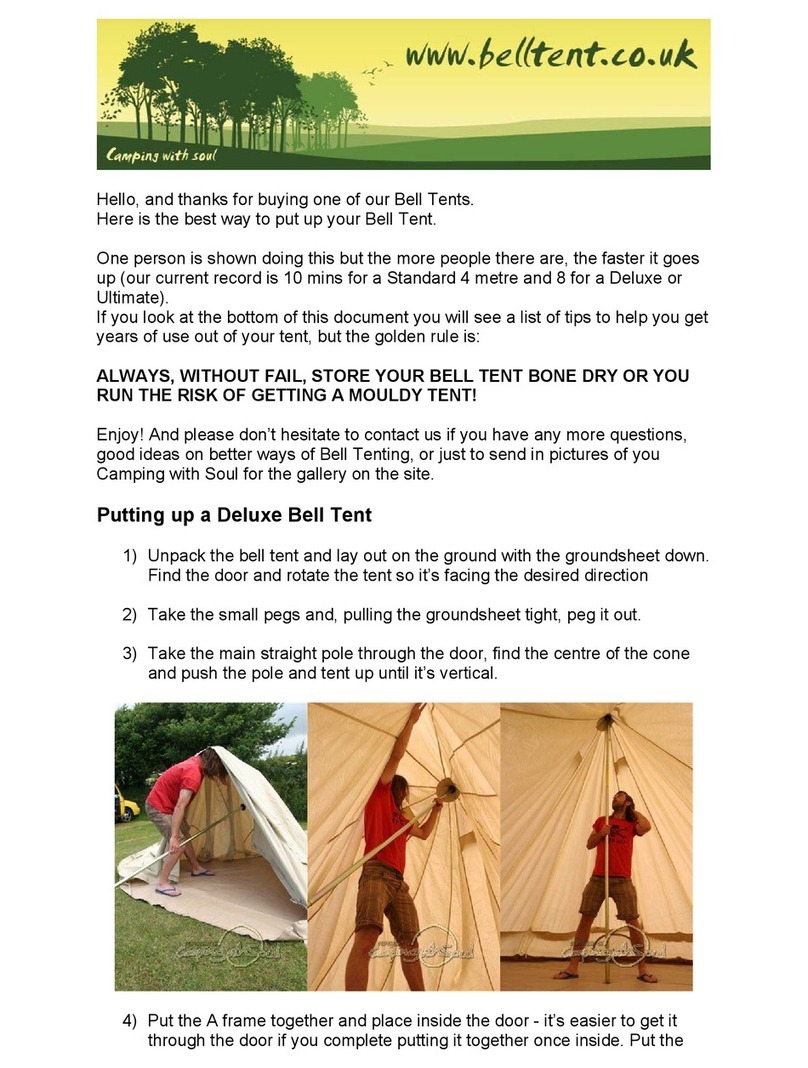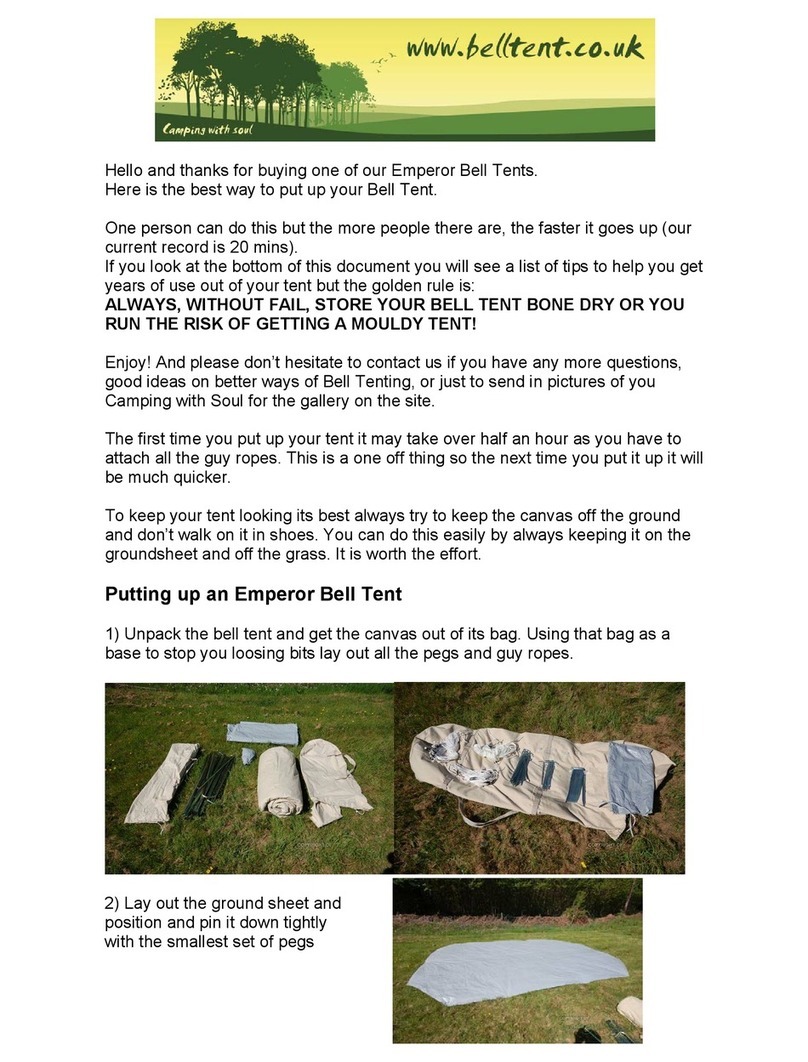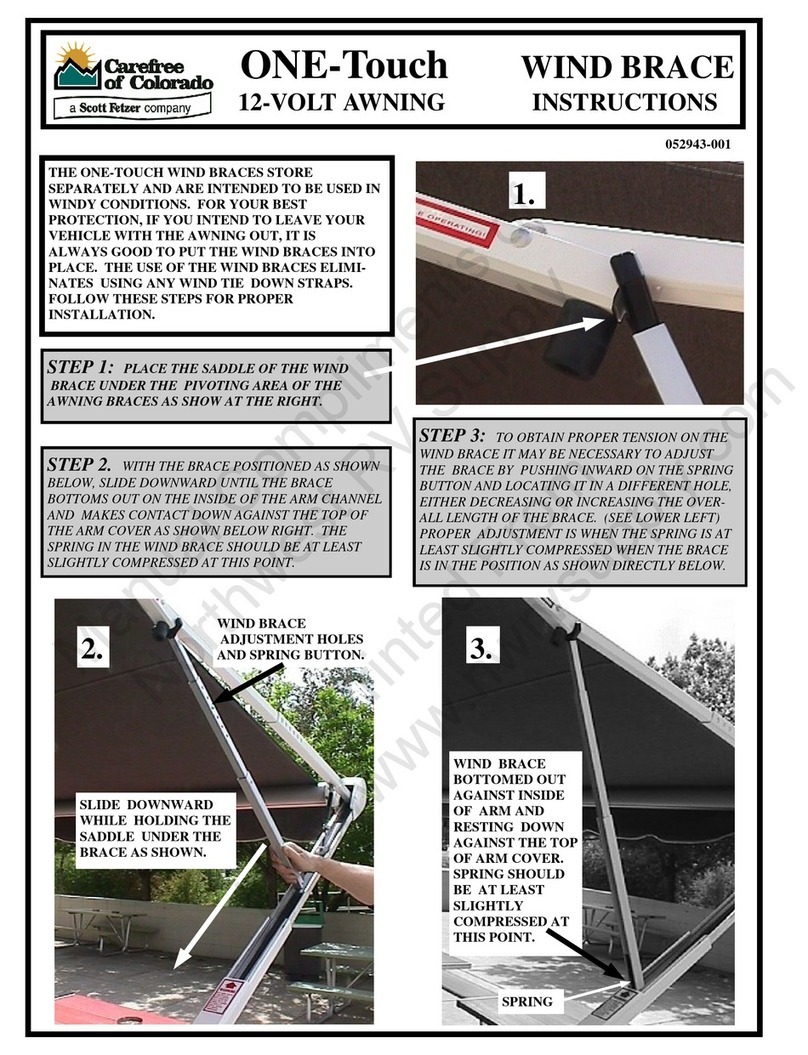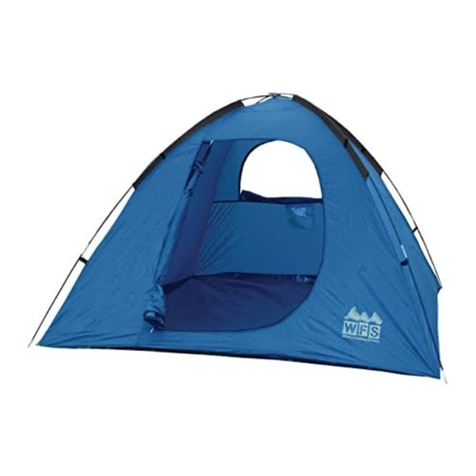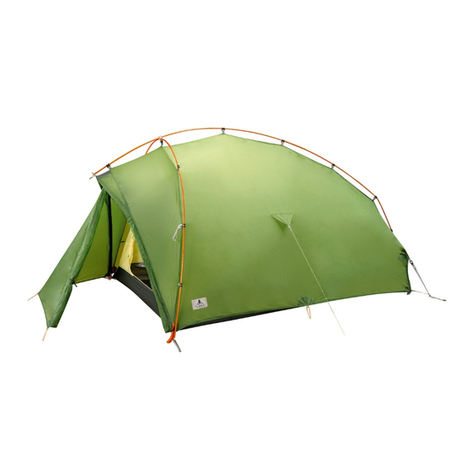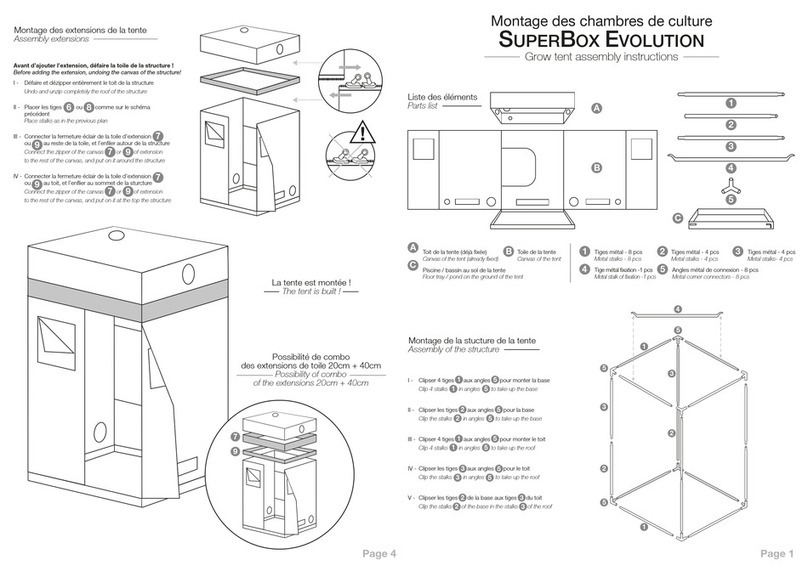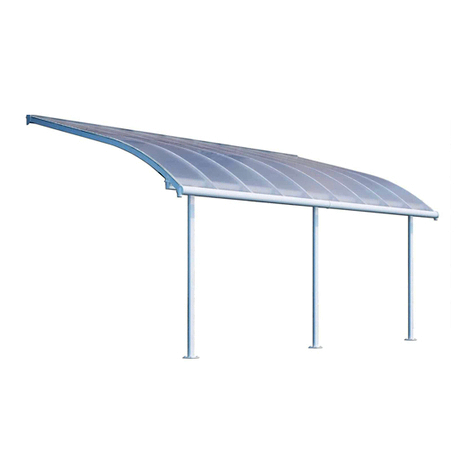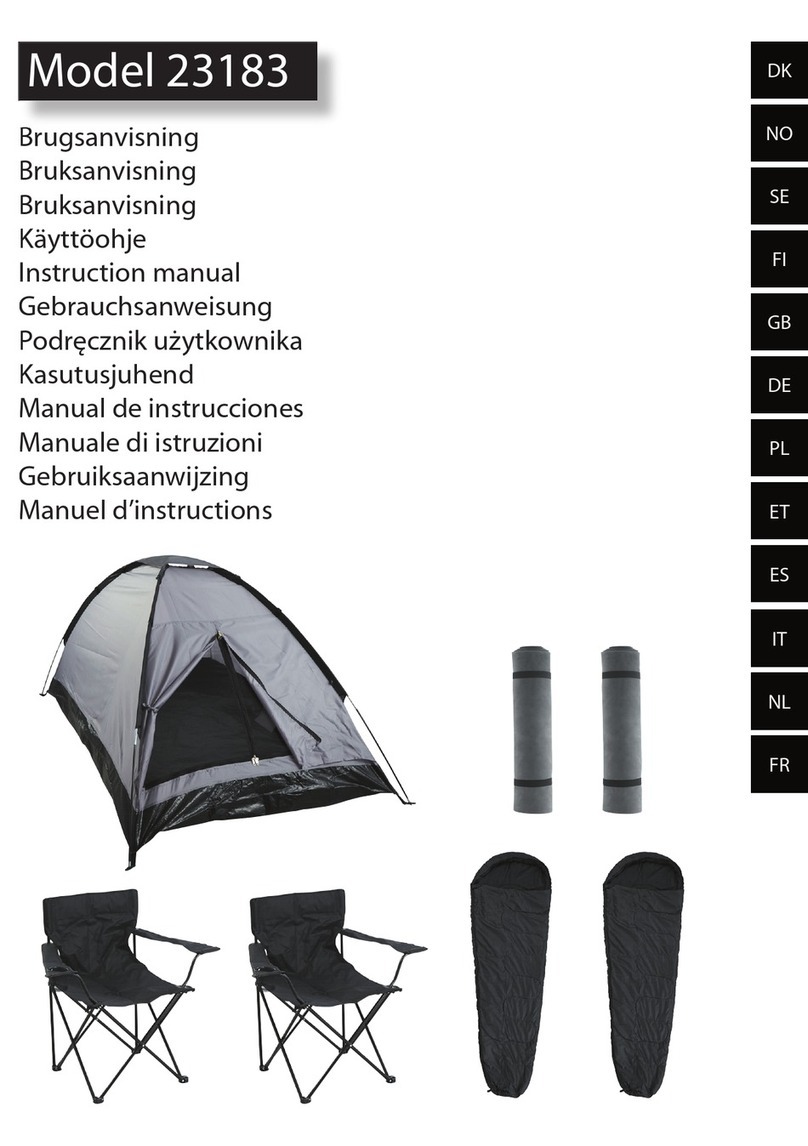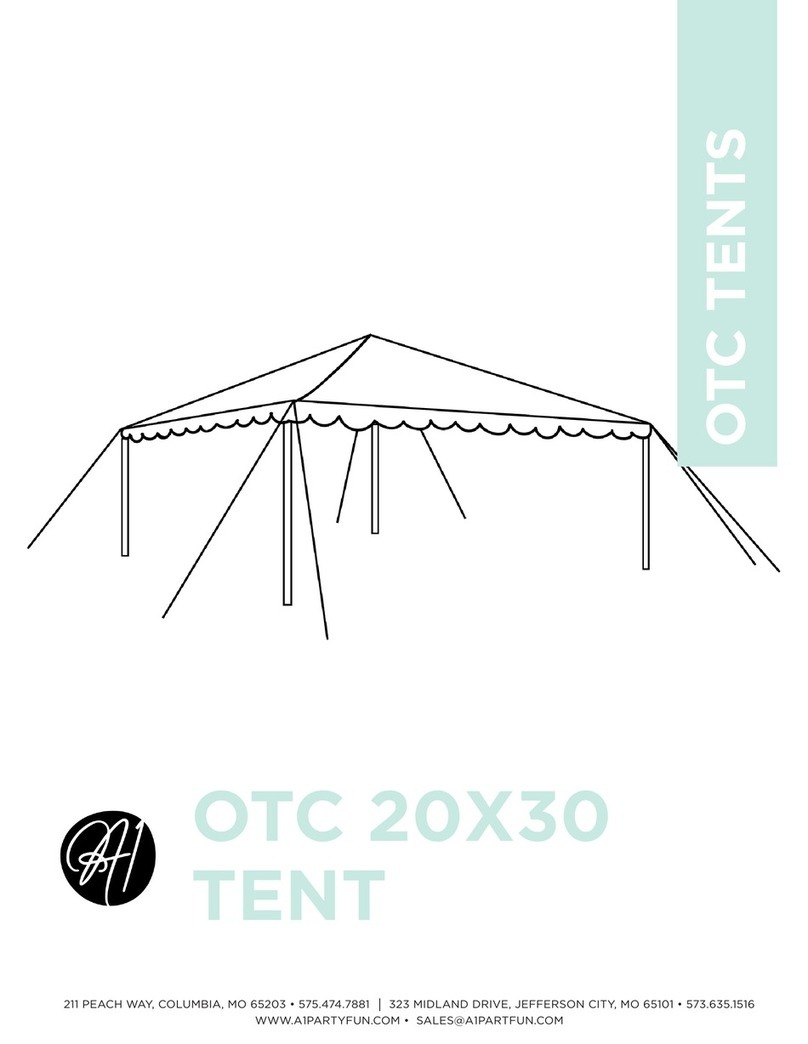Bell Tent Touareg User manual

Hello and thanks for buying one of our Touareg tents.
Here is the best way to put your tent up. One person is shown doing this but the
more there are the faster it goes up.
If you look at the bottom of this document you will see a list of tips to help you get
years of use out of your tent.
Enjoy!!! And don’t hesitate to contact us if you have any more questions, good
ideas on better ways of tenting or just to send in pictures of you Camping with
Soul for the gallery on the site.
Putting up a Touareg Tent
Some general advice
- We advise having 2 people to erect the tent as it will simplify the work but it’s
fine with just one if you follow the instructions below.
- Find a flat place big enough to put up your tent comfortably (including the guy
ropes) and remove all sharp objects, roots etc. to prevent damaging the
groundsheet.
- Be careful when you put the tent under tension with the guy ropes and always
try to keep the tension even.
- Make sure all zippers are closed before you peg out the tent and again when
you adjust the guy ropes and also make sure the guy ropes are pegged out in
line with the tent seams.
Now this is how to do it properly.
(If you have the Deluxe just lay it out, peg down the bottom of the walls and start
at point 4)
1) Unpack the tent
2) Lay out the ground sheet as flat as possible and
peg it down with the small pegs to stop it from blowing
away. You then should only keep the tent on the
groundsheet and off the floor. This stops it getting
stained.

3) Lay the canvas out on top of the
groundsheet and using middle sized
pegs peg the bottoms of the walls
down right next to the corresponding
pegs in the ground sheet.
4) Now you need to do a one off stringing.
This will take around 15 mins but you only
need to do it the once.
The Touareg will then take around a total
of 10 mins to erect.
Lay all the ropes and sort them into long
and short.
5) Always keep the canvas on the groundsheet (to stop it getting stained) and tie
the short ropes to the points on either side with the adjuster on the end away
from the tent.

5) Take the 4 long guy ropes and in the same way attached them to the loops at
the top of the doors front and back. When you do go to peg out the ropes slide
the adjuster some way from the end so you can then adjust both ways. The way
it works is to put the peg in the loop closest to the knot at the end of the rope. If
you try and use the loop further up it won’t adjust.
6) Unzip a door and starting with the longest pole position it in the middle of the
tent followed by the 4 medium sized poles that go at the corners of the door.
Don’t forget to fit the clear rain caps to each of these poles to stop the rain
getting in. We find it’s best to peg in each guy rope as you put each medium pole
up but be careful to do it loosely as you can adjust the tension once all the ropes
are up)

7) Once all 5 internal poles are up come out and zip the door up. Now go to
either side of the tent and fit the small poles to each corner of the tent peg.
Now peg out the short guy ropes and angle the two outside edge ropes slightly
away from the centre two to give more stability. Again start off quite loosely
otherwise you’ll end up with the tent leaning towards where you started.
8) Once all the guy ropes are in it’s now time to go round tightening all the
adjusters to get the tent good and taught.
9) Finally go round the tent tucking the skirt under the groundsheet from the
inside of the tent to create a weather resistant seal. It’s worth taking the time to
do this properly to avoid leaks. (not on deluxe)
Job done!!
Next time you put your Touareg up it will take a fraction of the time and you
should find it takes around10 mins.
Enjoy………
Taking down your Touareg and getting it back in the
bag.
You might think this is telling you how to suck eggs but if you follow this routine
your tent will stay clean, dry and last you for years.
It is VITAL that your tent is stored Bone Dry. If you have to take it down wet get it
straight out when you get home and hang it over something to start drying it out.
If you wait a day or so you run the risk of mould. Once you get that you’re stuck
with it as it grows in the material not just on it.
Hang it on a washing line, in the garage or over furniture, anywhere where it can
start to dry.

Taking down the Touareg.
The idea is to take the tent down on its groundsheet. This way it doesn’t touch
the ground and get stained and muddy.
If you have the deluxe go as far as point 5) and see the instructions at the end.
1) Get everything out of tent and brush out mud and dirt
2) Remove pegs on guy ropes
3) Remove poles and tent will drop on itself
4) Zip up door
5) Go round throwing all the guy ropes onto the centre of the tent
6) Put the bag next to the tent so you can tell how thick a roll you need to
create.
7) Take one side and fold over towards the middle so the edge ends up in
the middle of the tent.
8) Repeat on the other side
9) Repeat the folding until you end up with a roll the same width as the bag.
10)Fold in half towards the bag, Repeat
11)Now roll up and place roll on bag to stop grass stains.
12)Now un-peg the groundsheet. Unless you are in the driest of dry
conditions there will be condensation from the grass on the underside.
You need to let this dry off so, weather permitting, flip the ground sheet
over (don’t do it on the same spot as the condensation was) and give it a
couple of mins to dry off. A couple of pegs will stop if flying away and
consider laying it over something dry if the grass around is wet. (car ,
tarmac, fence, whatever) Not doing this means your storing a damp tent +
possible mould.) If you have to take it home damp pack it separately to the
tent, dry it off when home and then pack together
13)If you have to take the groundsheet home wet underneath try folding it in
on itself so the wet bottom to next to wet bottom and the outside was the
upside in the tent and will be dry.

14)Once dry fold in on itself until you end up a strip the same width as the
tent and fold it on itself until you have a square. Then slightly unroll the
tent. Put the groundsheet , poles and pegs on top and roll around them to
create a roll the correct size for the bag.
15)Use the ties to secure the roll and put it in the bag,
Job done and as the poles and pegs are secure in the middle of the tent they are
protected and you won’t leave them behind. (You’d be amazed how many calls
we get form people in fields on weekends desperate for poles of pegs that were
left at home!
Deluxe.
You want to adhere to the same rules as above as in keeping the canvas off the
ground unless its bone dry.
6) Having unpegged the whole deluxe tent fold it over once on itself so
that you’ve got half the groundsheet pointing at the sky and it’s canvas on
canvas.
7) Let that half of the underside dry off
8) Then move the tent so you’re away from the condensation left under it’s
footprint and roll it over so the other half of the underside can dry.
9) Once dry follow the normal instructions from 13)
Cleaning mud off my Tipi Tent
What with the British weather odds on you’ll get mud splattered onto if at some
point.
The best way to get it off is to leave it alone until it’s dried out. If that means
taking the tent out again when you get home then that’s what you need to do.
Once the tent is bone dry a stiff hand brush will work miracles. If you mess
around with wet mud and wet cloths you’ll end up just rubbing it in.
To clean the Groundsheet wash it with a hose and brush or not to powerful
jetwash and allow to dry.
Any problems feel free to call us , even if it’s a weekend we’ll try and answer or
things so please let us know if you have any ideas of how to do anything quicker
of better.
We hope you have loads of fun with your tent and as long as it’s stored correctly
it should give you years of pleasure.
ENJOY and see you in a field soon!!

Here’s some other general info.
Cotton.
Cotton tent canvas can be divided into three different kinds: lightweight,
middleweight and heavyweight canvas.
Lightweight canvas weighs between 130 and 180 gr/m² and is suited for
lightweight expeditions on foot.
Middleweight canvas weighs between 180 and 220 gr/m² and is used for tents
designed to remain for longer periods in one place.
Heavyweight canvas weighs 220 to 320 gr/m². Bungalow tents, group tents and
army tents are being made out of this.
Therefore U just bought what is rated as a
heavy-weight canvas tent.
Cotton shrinks when wet, making itself waterproof when it rains.
The canvas has been impregnated to protect it from dirt, ultraviolet radiation and
fungus.
Advantages Cotton / Canvas:
- Strong
- Breathing and humidity regulating
Disadvantages cotton:
- Dries slowly
- Sensitive for dirt and fungus
Maintenance:
The cotton must be dry before storing the tent. Never keep the tent stored away
wet for longer than two days. Otherwise fungus can affect the canvas witch will
create little black irremovable dots. The canvas has been impregnated with anti-
fungi but when using the tent often this process should be repeated every two
years. Maintenance starts when setting up the tent. When the tent has not been
erected properly uneven forces will pull on the canvas. This could eventually lead
to damage. It is in your interest to keep the canvas as clean as possible and
remove stains when created. Dust can best be wiped away with a soft brush,
soft!

Lifespan:
The lifespan of your tent is very dependent upon camping conditions. Air
pollution, ultraviolet radiation, natural dirt (bird droppings, sand, salt water) and
domestic dirt (cooking stains, soda, wine, sun cream) limit the lifespan of your
cotton canvas tent.
- Lightweight canvas last 15 to 40 weeks.
- Middle-weight cotton canvas 20 to 40 weeks
- Heavy-weight canvas 40 to 60 weeks of outdoor usage.
Zippers:
Zippers sometime have to endure extreme tension caused by wind, badly
erected, pressures caused by people or object leaning into the tent.
Tip:
- Close all zippers before erecting the tent.
- Handle the zippers with care.
- To protect the zippers treat them with silicones once in a while.
- Verify zippers before using, no insurance on zippers after use.
Fungus and stains:
Due to insufficient ventilations fungus can affect the canvas. It is important to
store your tent dry so no fungus or other stains can appear. When you have to
temporarily store the tent wet be sure to remove the mud and dirt from the
bottom of the tent put your tent back out to dry ASAP.
Tip:
- Store your tent 100% dry.
- When dealing with fungus use a soft brush or sponge and a lot of fresh water.
Only use specialised tent cleaning product to remove difficult stains. Other
chemical products can cause the cotton to leak. We suggest you have your tent
re-impregnated after washing it.
Leaking:
Cotton can, when new, let some air through and leak around the seams. After the
canvas has been wet once this will no longer happen because of the cotton
expanding. Very light stains can appear on a wet tent, this causes no problems.
Mainly because of ultraviolet radiation working in on the tent this layer will wear
down no longer making the tent waterproof.
Tip:
- To preserve your tents water resistance and prolong its lifespan, the outside
should be regularly treated with a sealant (good spay can sealants on the market)
www.belltent.co.uk [email protected] 07830 355993
Copyright © 2009 Bell Tent UK
Table of contents
Other Bell Tent Tent manuals
Popular Tent manuals by other brands
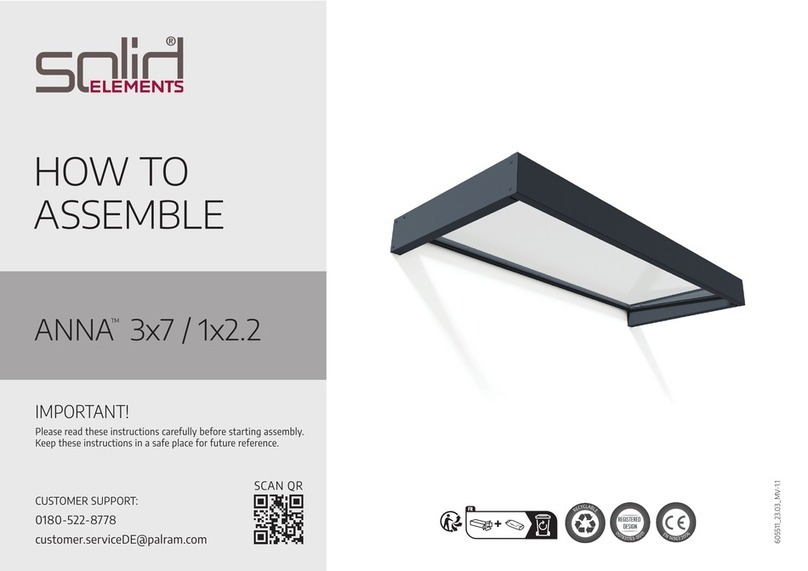
Palram
Palram solid ANNA 3x7/1x2.2 How to assemble

COVERPRO
COVERPRO 63297 Owner's manual & safety instructions
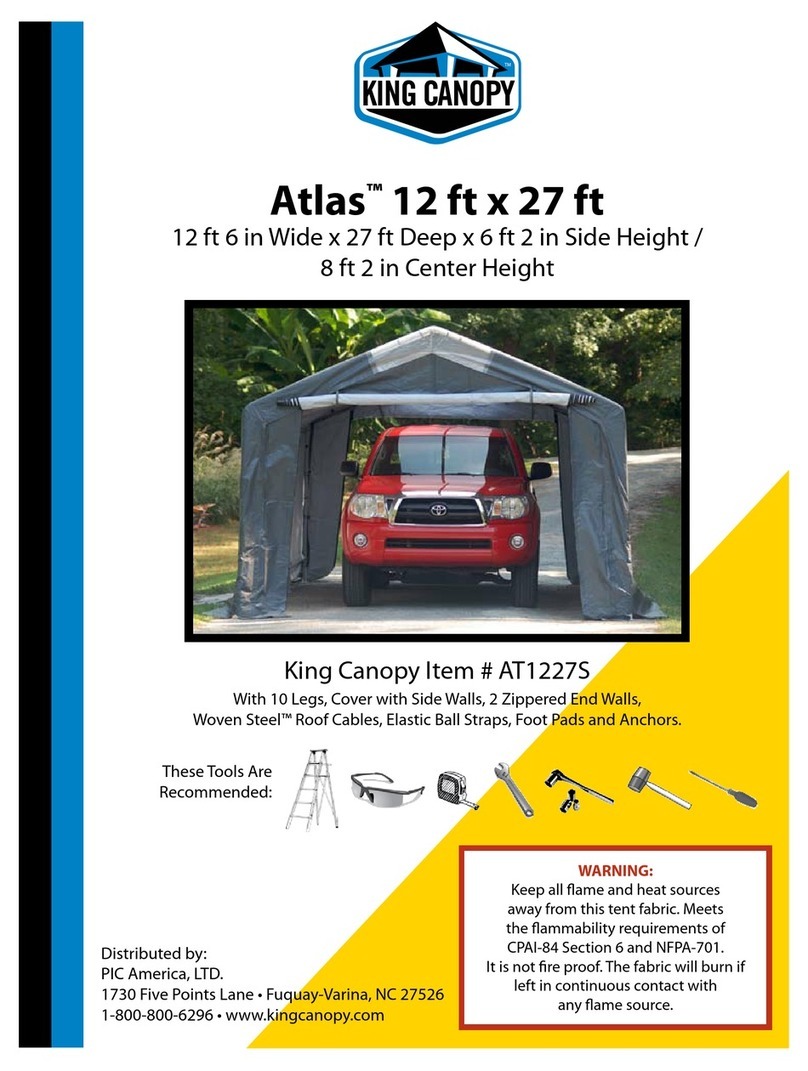
KING CANOPY
KING CANOPY Atlas AT1227S Assembly instructions

ELC
ELC Princess Castle instructions
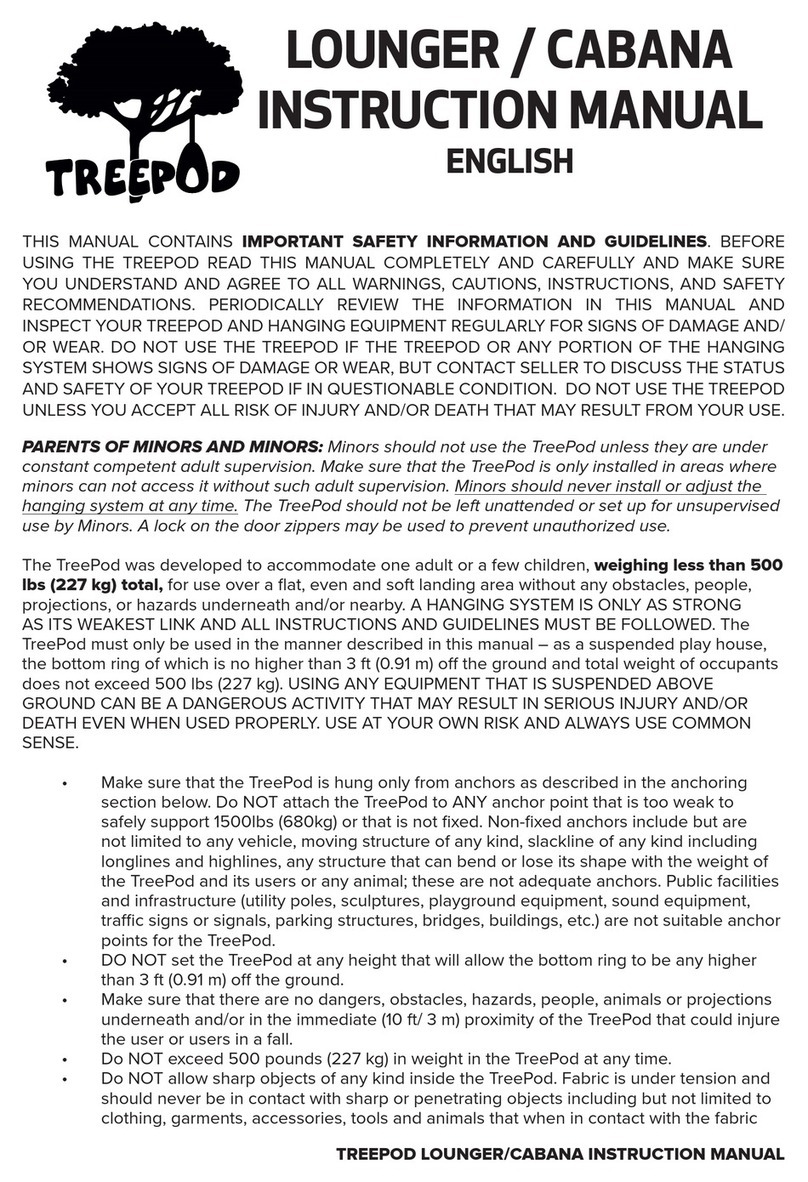
TREEPOD
TREEPOD Lounger instruction manual

ARB Touring
ARB Touring ESPERANCE ANNEXE 804200 FITTING INSTRUCTION
